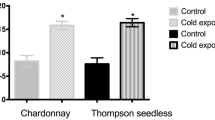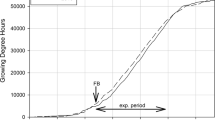Abstract
Several symptoms are described that characterize the extent of flower-bud blasting in tulips. The disorder could be induced by ethylene applied in concentrations of 0.3 ppm and higher during storage of the bulbs. When ethylene was applied late, the symptoms could be observed in most of the buds immediately after exposure. During subsequent storage in an ethylene-free environment, the injury often increased. When ethylene was applied early, symptoms of blasting appeared only after subsequent treatment for early flowering.
The injury was worse the longer the storage period before exposure, the higher the storage temperature, the higher the concentration of ethylene, the longer the exposure period. Large differences in susceptibility between a number of tested cultivars were observed.
Samenvatting
De mate van beschadiging bij bloemknopverdroging is gekarakteriseerd in een aantal stadia varierend van 0 (geen symptomen) tot 7 (spruit geheel verdroogd). De afwijking kon worden opgewekt door tijdens de bewaarperiode ethyleen toe te dienen in concentraties van 0,3 dpm en hoger. Wanneer ethyllen laat (vanaf eind augustus) werd toegediend, konden de symptomen meestal direct na de behandeling worden waargenomen (Fig. 1). De mate van beschadiging was dan groter naarmate:
-
1.
de bewaring voorafgaande aan de ethyleenbehandeling langer had geduurd (Tabel 1),
-
2.
de bewarrtemperatuur hoger was (Fig. 5),
-
3.
de ethyleenconcentratie hoger was (Fig. 6),
-
4.
de blootstelling aan het gas langer duurde (Fig. 7).
Er bleken grote verschillen in gevoeligheid te bestaan tussen een aantal onderzochte cultivars (Tabel 2). Wanneer met-ethyllen-behandelde bollen werden geplant, ontwikkelde zich in een aantal gevallen uit okselknoppen-waaruit onder normale omstandigheden een nieuwe bol groeit — een spruit met bloem (Fig. 2). De verschijnselen werden directe effecten van ethyleen genoemd.
Na blootstelling aan het gas nam de mate van beschadiging tijdens voortgezette bewaring in ethyleenvrije omgeving in de meeste gevallen toe (Fig. 8A en B). Deze toename werd een uitgesteld ethyleen-effect genoemd.
Een ander uitgesteld ethyleeneffect trad op wanneer ethyleen vroeg in de bewaarperiode werd toegediend en de bollen daarna werden geplant en behandeld voor vroege bloei (koeling bij 5δC en in bloei trekken in een kas bij 18 tot 20°C). De verdrogingsverschijnselen ontstonden nu tijdens de groeifase in de kas (Fig. 3 en 4). Ook bij dit effect bleken verschillen in gevoeligheid tussen de onderzochte cultivars (Tabel 3). Bij deze behandeling bleek bovendien, dat de uitgroei van de wortels in een aantal gevallen werd geremd als gevolg van de voorafgaande ethyleenbehandeling (Fig. 9).
Similar content being viewed by others
References
Algera, L., 1947. Over den invloed van de temperatuur op de koolhydraatstofwisseling en ademhaling bij de tulp en de hyacinth en de beteekenis daarvan voor de ontwikkeling der plant. Meded. Landb-Hogesch., Wageningen 48:87–183.
Beijersbergen, J. C. M. & Lemmers, C. B. G., 1971. Enzymic liberation of tulipalin (α-methylenebutyrolactone), a fungitoxic substance isolated from tulips. In: First int. Symp. Flowerbulbs, Noordwijk/Lisse, 30 March-4 April 1970. Vol. 2: 230–234. Int. Soc. hort. Sci., Den Haag.
Biale, J. B. & Shepherd, A. D., 1941. Respiration of citrus fruits in relation to metabolism of fungi. I. Effect of emanations ofPenicillium digitatum Sacc. on lemons. Am. J. Bot. 28:263–270.
Borriss, H., 1943. Über das Wesen der wachstumshemmenden Wirkung des Äthylens. Jb. wiss. Bot. 91:83–119.
Davidson, O. W., 1949. Effect of ethylene on orchid flowers. Proc. Am. Soc.hort. Sci. 53:440–446.
Erickson, R. O., 1948. Cytological and growth correlations in the flower bud and anther of Lilium longiflorum. Am. J. Bot. 35:729–739.
Harvey, E. M., 1915. Some effects of ethylene on the metabolism of plants. Bot. Gaz. 60:193–214.
Hitchcock, A. E., Crocker, W. & Zimmerman, P. W., 1932. Effect of illuminating gas on the lily, narcissus, tulip and hyacinth. Contr. Boyce Thompson Inst. Pl. Res. 4:155–176.
Hoogeterp, P., 1969. Enkele aspecten van de vroegste bloei van tulpen in kisten. Vakbl. bloemisterij 24:542–543.
Kamerbeek, G. A. & Durieux, A. J. B., 1971. Influence of light on flower bud abscission in plants of the lily cultivar ‘Enchantment’. In: First int. Symp. Flowerbulbs, Noordwijk/Lisse, 30 March — 4 April 1970. Vol. 1:71–74. Int. Soc. hort. Sci., Den Haag.
Kamerbeek, G. A. & Munk, W. J. de, 1968. Kernrot in tulpen. Jversl. Lab. BloembollenOnderz. Lisse, 1967–1968:26–27.
Kamerbeek, G. A., Verlind, A. L. & Schipper, J. A., 1971. Gummosis of tulip bulbs caused by ethylene. In: First int. Symp. Flowerbulbs, Noordwijk/Lisse, 30 March—4 April 1970. Vol. 1: 167–172. Int. Soc. hort. Sci., Den Haag.
Mastalerz, J. W., 1965. Bud blasting inLilium longiflorum. Proc. Am. Soc. hort. Sci. 87:502–509.
Munk, W. J. de, 1977a. Bud necrosis, a storage disease of tulips. III. Influence of ethylene and mites. Neth. J. Pl. Path. 78: 168–178.
Munk, W. J. de, 1972b. Papierblütigkeit der Tulpen. Gartenwelt 71:421–422.
Munk, W. J. de, 1973. Bud necrosis, a storage disease of tulips. IV. The influence of ethylene concentration and storage temperature on bud development. Neth. J. Pl. Path. 79:13–22.
Munk, W. J. de & Rooy, M. de, 1971. The influence of ethylene on the development of 5°C-precooled ‘Apeldoorn’ tulips during forcing. Hort. Sci. 6:40–41.
Nard, M. le & Cohat, J., 1968. Influence des températures de conservation des bulbes sur l'élongation, la floraison et la bulbification de la tulipe (Tulipa gesneriana L.). Annls. Amél. Pl. 18:181–215.
Rees, A. R., 1967. The effect of high temperatures of tulip bulbs (‘blind stoken’) on flowering and bulb yield. Rep. Glasshouse Crops Res. Inst. 1966:126–129.
Ress, A. R., 1969. Effect of duration of cold treatment on the subsequent flowering of tulips. J. hort. Sci. 44:27–36.
Slogteren, E. van, 1937. The influence of different temperatures on development, growth and flowering of hyacinths, tulips and daffodils. Gartenbauwissenschaft 11:17–34.
Uota, M., 1970. Sleepiness of carnation blooms-how much ethylene does it take? Flor. Rev. 146: 35 and 65–67.
Author information
Authors and Affiliations
Rights and permissions
About this article
Cite this article
De Munk, W.J. Flower-bud blasting in tulips caused by ethylene. Netherlands Journal of Plant Pathology 79, 41–53 (1973). https://doi.org/10.1007/BF02083665
Accepted:
Issue Date:
DOI: https://doi.org/10.1007/BF02083665




